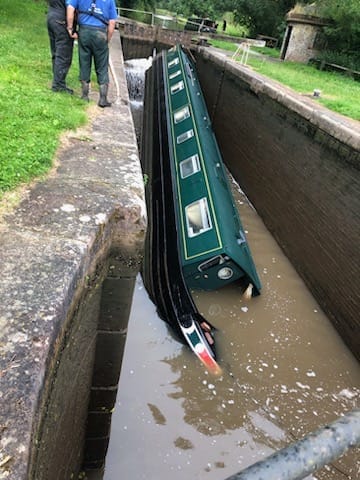
Fifty major incidents in three months for River Canal Rescue

River Canal Rescue (RCR) has reported its teams, from 1 June to 31 August this year, responded to an unprecedented number of call outs. Those included fifty major incidents involving submerged, partially sunken or grounded craft.
The company, which offers marine breakdown assistance, says a high proportion of the major incidents were due to boats being trapped and submerged in locks, after getting stuck on lock cills, people missing signage, and underwater damage.

That happened in late July, when the team was called to Lock 13, Tilston lock, on the Shropshire Union canal. A boat hired from Anglo Welsh was caught on the lock cill, causing the stern to stay in place while the bow lowered in line with the dropping water level, sinking the vessel.
The vessel was held on the lock cill by one inch of rudder, making it unstable. As the three-man RCR team could not enter the boat (health & safety) the only option was to flood the lock and float the boat off the cill. After approval from Anglo Welsh, the lock was flooded and the boat sunk to the bottom of the lock safely with guide ropes and winches.
Now stabilised, after emptying the lock, the team sealed entrances and pumped-out the vessel while the lock was refilled. Once refloated it was moved and recovered by Anglo Welsh (which still offers canal boat holidays for beginners).
“There are numerous reasons why boats get trapped on lock cills . . . you may not be used to the lock and accidentally push your boat further over the cill or perhaps lose concentration for a second which can be disastrous,” says RCR managing director, Stephanie Horton.
There were more incidents on rivers than canals, and the river Trent at Sawley appears to be an incident hotspot, she says.

“Not seeing signage or poor signage is an issue. On the river Trent at Sawley there’s a huge sign with chevrons telling you to keep left, but people miss it, and frequently become grounded in the wrong channel.
“There are many cases of people going the wrong way – usually when rivers are in flood and weirs and locks may be difficult to see. Then boaters sometimes don’t have enough power to change their route and end up trapped on weirs.”
Underwater damage to props, hulls, skegs and tiller cups is equally common, mainly due to the amount of debris found in rivers and canals due to fly tipping. Dumped mattresses, clothing and wiring are the main culprits, with low water levels making things worse.
With canals silting up, grounding is also becoming a problem, as are clogged-up fuel filters caused by sticky fuel and diesel bug.
“This spike in numbers certainly stretched our entire staff,” says Horton. “Everyone at RCR is rescue-trained, but for major incidents we have six rescue engineers. As there were high demands on their time, our 19 general breakdown engineers pitched in to help, which in turn put pressure on their call-outs and return visits with parts. We were however, able to support everyone who called us, meeting our ethos to get boaters moving again as soon as possible with minimum disruption and cost, and to keep the navigation clear.”
As well as the major incidents, Horton says there were 1,200 general call-outs. The latter are typically for electrical, fuel and engine issues, flat batteries, over-heating and gear box failures. Those were evenly spread across the UK with the top three reasons being fuel issues, fouled props and engine overheating.
“With the Met Office reporting this summer was the coolest since 2015, I thought the poor weather may have put people off taking to the water, but this wasn’t the case. There seems to be more boaters enjoying our inland waterway system, and I suspect our high call-out figures are either due to the cost-of-living crisis, prompting more people to enjoy a staycation on the water, or owners spending less on boat maintenance.”
The post Fifty major incidents in three months for River Canal Rescue appeared first on Marine Industry News.
